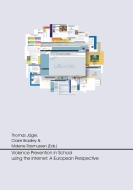|
 This book gives an overview of violence
and violence prevention in five countries with a focus on resources that
are available on the Internet. In this context we present selected web
sites from Denmark, Finland, Germany, Portugal and the UK and give an
overview of the situation in these countries. This book gives an overview of violence
and violence prevention in five countries with a focus on resources that
are available on the Internet. In this context we present selected web
sites from Denmark, Finland, Germany, Portugal and the UK and give an
overview of the situation in these countries.
The book is for teachers, educators, parents and others who are affected
by violence in school in their daily work or life, and who are interested
in how the problem of violence in school is dealt with in other countries.
The book is complemented by a separate section on VISIONARY Internet
portal that provides access to a constantly changing and growing pool of
information on all the areas that are covered in the book. Summaries of the book's chapters:
Chapter 1,
Introduction - background, concept and structure of
this book, gives an overview of the
background and concept of the book. It outlines how the VISIONARY website
and the book complement each other and gives an outline of each of the
chapters in the book.
Chapter 2, Supporting violence prevention in
school using the Internet, gives an overview
of basic concepts relating to the Internet, different ways of searching
for information, communicating with others, and the concept of online
communities. As an example of how these different aspects are combined and
as the starting point for this book, the VISIONARY web site is presented.
Chapter 3, Violence in school,
introduces definitions of violence and bullying in school, and also its
prevalence and sources, in Denmark, Finland, Germany, Portugal and the UK.
It reveals the differences and similarities between definitions and
concepts within and between our countries and presents common tendencies
in terms of the prevalence of violence. Furthermore, this chapter reveals
that aggressive and violent behaviour is caused by a broad variety of
sources that interact in a complex way, and points out the necessity that
programmes or activities that combat aggressive or violent behaviour
should focus on multiple rather than single sources.
Chapter 4, Violence prevention in school,
first clarifies the concept of violence in school and its sources (individual,
academic, cultural and social). Based on international research, it
stresses some of the main features of the pedagogical context and the
problem of violence in school. The chapter introduces primary, secondary
and tertiary preventive measures that can be implemented in schools. It
also presents a theoretical and practical set of measures to improve
relationships within school and increase the participation of the
different actors (teachers, pupils and parents) at the classroom and
school level.
Chapter 5, Activities for violence prevention
in school, outlines a variety of different
types of activities against violence in schools, based on the system of
categories in the link collection of the VISIONARY portal. For each
category, a theoretical introduction and several examples of web sites are
given.
Chapter 6, Violence prevention in school:
initiatives and Internet resources in Denmark,
gives an overview about the Danish school system and crime prevention in
Denmark. Furthermore, it presents selected web sites and projects from
various fields and outlines trends concerning violence prevention in
school in Denmark
Chapter 7, Violence prevention in school:
initiatives and Internet resources in Finland,
gives an overview of school violence prevention in Finland, focusing
especially on materials and projects that can be found on the Internet. In
addition to this, the chapter includes information on Finnish projects,
associations and organisations offering support and advice for children,
adolescents and their educators. Examples of national organisations and
local projects are included that focus on preventing violence in schools,
supporting mental well-being, and improving the social environment of
children and youth.
Chapter 8, Violence prevention in school:
initiatives and Internet resources in Germany,
introduces violence prevention in school in Germany, and considers
specific issues that stem from the federal structure and complex
educational system in Germany. It gives an overview of German resources
related to violence prevention in school on the Internet, such as for
instance German portals, initiatives, organisations and campaigns.
Selected web sites and projects are presented giving an insight into
popular concepts, ideas and resources in Germany.
Chapter 9, Violence prevention in school:
initiatives and Internet resources in Portugal,
presents the main initiatives from the Portuguese educational system
relating to violence prevention in school and the promotion of values that
instil peace and good citizenship. It gives an overview of Portuguese
resources related to violence prevention in school on the Internet and
presents the main web sites and projects.
Chapter 10, Online communication and
communities addressing bullying: a UK perspective,
reviews some of the approaches to bullying and violence prevention that
are currently being employed by schools within the UK. It also outlines
the Internet's role in bullying and violence prevention in UK schools and
presents selected projects and web sites from the UK. |
 This book gives an overview of violence
and violence prevention in five countries with a focus on resources that
are available on the Internet. In this context we present selected web
sites from Denmark, Finland, Germany, Portugal and the UK and give an
overview of the situation in these countries.
This book gives an overview of violence
and violence prevention in five countries with a focus on resources that
are available on the Internet. In this context we present selected web
sites from Denmark, Finland, Germany, Portugal and the UK and give an
overview of the situation in these countries.